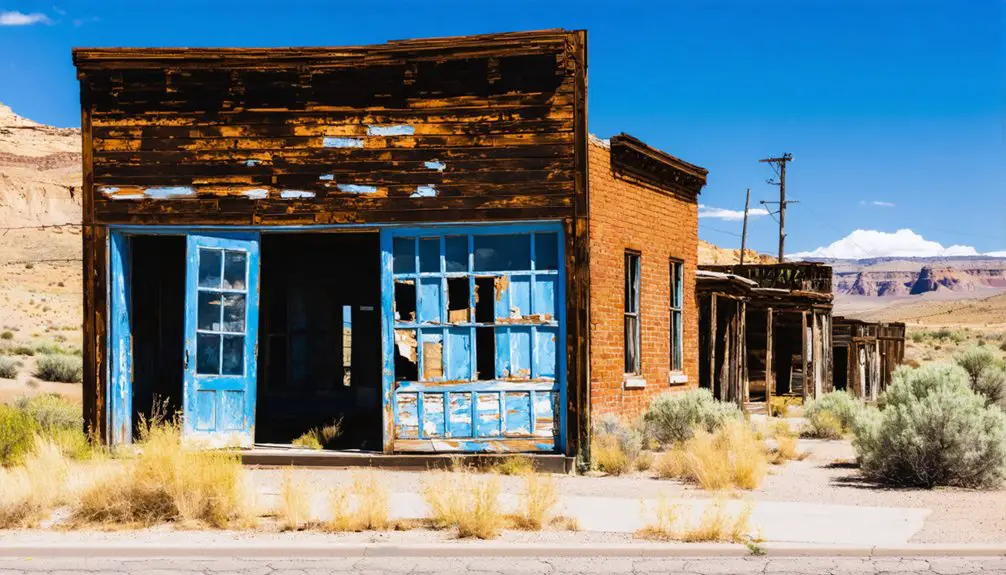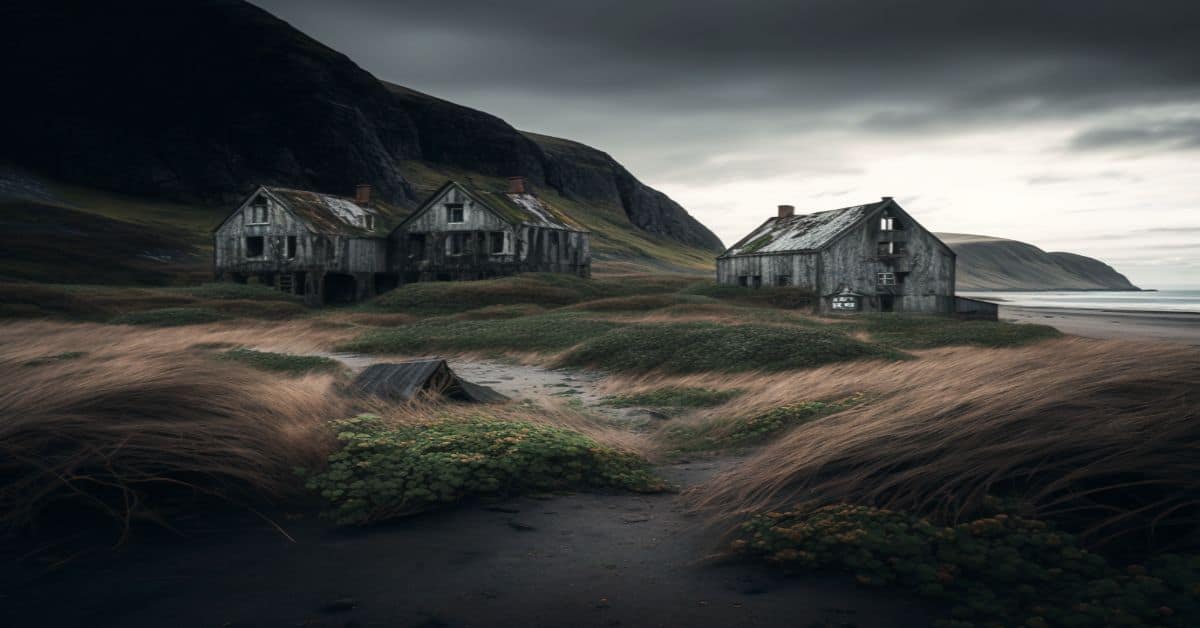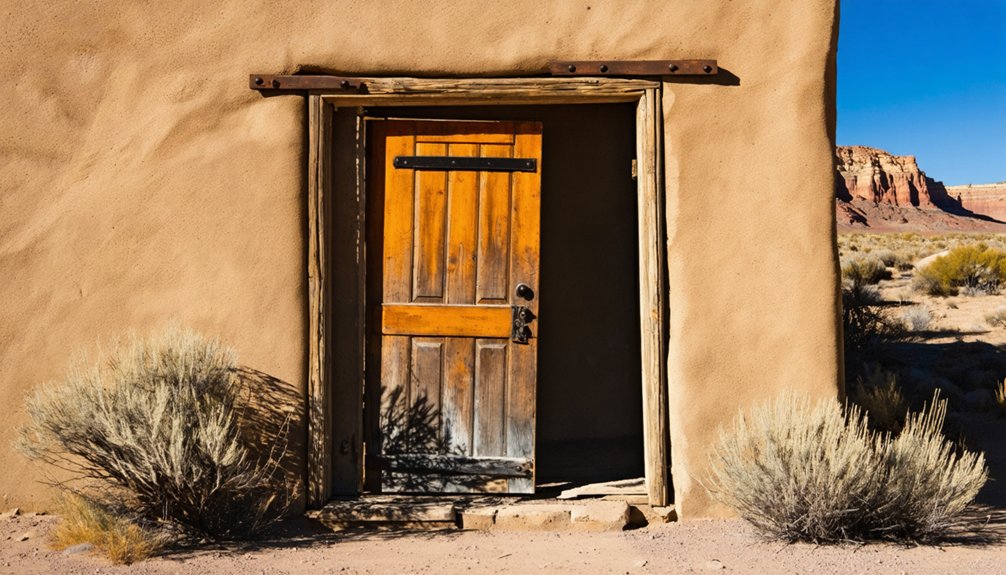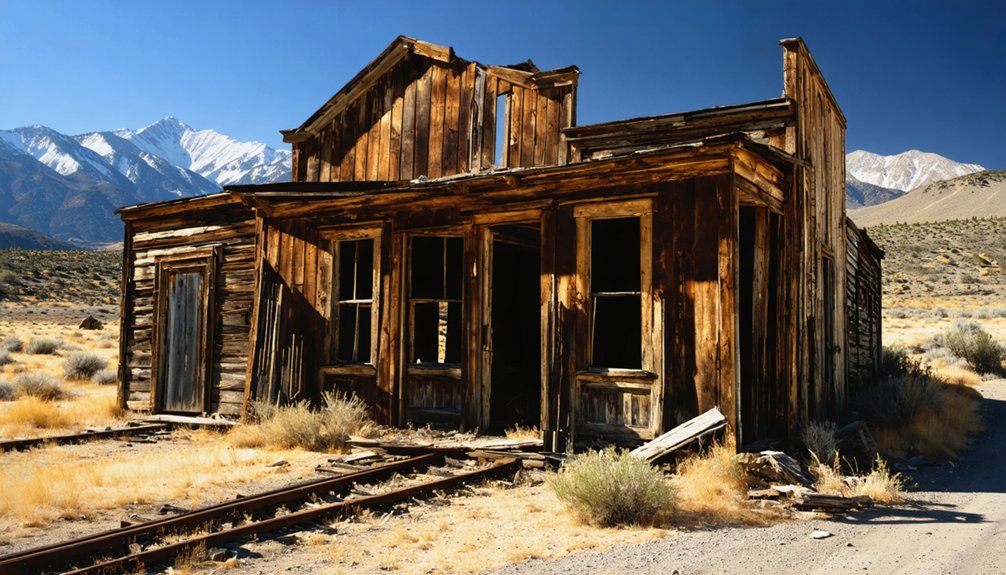You’ll find Soldier Summit perched at 7,700 feet in Utah’s Wasatch Mountains, where a tragic 1861 blizzard claimed the lives of seven U.S. Army soldiers and gave this once-bustling railroad town its name. The town flourished in the 1920s as an essential railroad hub, reaching 2,500 residents before declining. Today, you can explore the remaining two-room jailhouse and scattered cabins, while grass-covered mounds mark the soldiers’ final resting place. The site’s rich history holds countless untold stories.
Key Takeaways
- Soldier Summit, located at 7,440 feet elevation in Utah, was once a thriving railroad town with 2,500 residents before becoming abandoned.
- The ghost town features remaining structures including a two-room jailhouse, scattered cabins, and historic soldier memorial sites.
- Named after soldiers who perished in an 1861 blizzard, their graves marked by grass-covered mounds remain visible today.
- The town’s decline followed the decreased importance of railroad operations, transforming from a busy transportation hub into a ghost town.
- Visitors can explore the abandoned town’s remnants while experiencing the harsh mountain conditions that challenged its original inhabitants.
The Tragic Origin Behind the Name
While many Utah place names have obvious origins, the story behind Soldier Summit‘s name stems from a tragic event in July 1861.
During the early months of the Civil War, a group of U.S. Army soldiers from Camp Floyd, under General Philip St. George Cooke, were caught in an unexpected summer blizzard while crossing this 7,477-foot mountain pass.
The soldiers’ sacrifice became forever etched in the region’s history when several of them perished from exposure in the harsh conditions.
You’ll find their final resting place marked by a marble headstone reading “7 unidentified U.S. Soldiers who perished, 1861.”
Though various accounts exist about the exact circumstances, the historical significance of their deaths gave this strategic mountain passage its enduring name.
Before this tragic incident, Native American guides led Fathers Escalante and Dominguez through what they called Grassy Pass in 1776.
The discovery of gold and silver in the post-Civil War era brought new life to the region, leading to significant westward expansion.
Native American Heritage and Spanish Discovery
Long before European settlers ventured into the region, Native American tribes recognized Soldier Summit’s strategic importance as an essential pathway connecting the Colorado and Great Basin regions.
Following ancient Native American trade routes, tribes moved seasonally between hunting grounds while utilizing the pass’s significant freshwater spring.
Spanish exploration impact began in 1776 when Friars Domínguez and Escalante documented their journey through what they called Grassy Pass.
Their expedition relied heavily on Native American guides who shared their deep knowledge of the challenging terrain.
While the Spanish missionaries sought to convert local tribes to Christianity, they never established permanent settlements in the area.
The pass remained primarily indigenous territory throughout the 18th century, serving as a proof of the sophisticated travel networks developed by Native Americans long before European contact.
The Spanish explorers documented their journey in detail as they searched for an overland route to Monterey.
In 1861, a group of General Cooke’s soldiers perished in an unexpected July snowstorm at the summit, giving the location its modern name.
Railroad’s Golden Era at the Summit
The golden age of railroading transformed Soldier Summit into an essential transportation hub in 1878 when the Utah & Pleasant Valley Railway constructed its narrow gauge line to access the Scofield coal mines.
The rise of rail travel birthed a vital hub at Soldier Summit, as narrow gauge tracks first linked the rich Scofield coal fields.
You’ll find remarkable railroad engineering feats here, where crews laid 6,000 feet of track from Clear Creek station before winter stopped their progress.
When the Denver & Rio Grande Western Railway purchased the line in 1882, they modernized the route with heavier rails and proper ballasting.
At 7,440 feet elevation, it’s one of America’s highest rail passes. The challenging 4% grade demanded powerful locomotives as trains hauled coal across the Wasatch Mountains. In 1913, joint trackage agreements were established with Denver & Rio Grande Railroad to improve operational efficiency. Today, the once-bustling route sees only 2-3 weekly trains from the Scofield mine.
Life in a Mountain Town: 1920s Prosperity
As you’d discover in 1920s Soldier Summit, railroad workers earned steady wages that fueled a bustling commercial district of stores, hotels, and entertainment venues.
Your ancestors might’ve gathered at the billiard hall, restaurants, or one of several saloons after their shifts maintaining the essential railroad operations at 7,700 feet.
The D&RGW machine shops brought significant employment when they relocated to the town, attracting skilled workers and their families.
The growing Mormon community established a strong presence, progressing from a branch to a ward by 1927, while sharing the spiritual landscape with another church and a YMCA that served the town’s 2,500 residents.
Railroad Jobs and Wages
During Soldier Summit’s peak prosperity in the 1920s, railroad jobs formed the economic backbone of this mountain community, employing hundreds of skilled workers at 7,700 feet elevation.
You’d find helper engineers guiding trains up steep grades, maintenance crews battling harsh weather, and machine shop workers servicing locomotives after their relocation from Helper.
Railroad employment offered steady wages that reflected the demanding nature of mountain railroading. You could earn a reliable living working as a yard switcher, track maintainer, or administrative staff member.
Wage fluctuations often tied directly to coal shipping volumes, as agreements with Utah Railway and Lion Coal Company drove freight traffic. The work wasn’t easy – you’d face severe winters, long hours, and challenging conditions – but the railroad’s prosperity supported a thriving town of 2,500 residents. United States Fuel Company was a major driver of employment through its parent ownership of Utah Railway, ensuring steady work opportunities in the region.
Commerce and Entertainment District
Railroad prosperity fueled a bustling commercial district in Soldier Summit after its 1921 incorporation, transforming the mountain outpost into a vibrant town of 2,500 residents.
Local commerce trends reflected the needs of railroad workers and travelers, with multiple stores, hotels, saloons, and restaurants thriving throughout the 1920s.
You’d find entertainment options centered around the saloons and hotels, which served as social hubs where workers gathered after their shifts. The town’s two churches provided additional community activities, while school functions brought families together.
The commercial district’s success remained closely tied to the railroad’s presence – when operations moved to Helper in 1930, businesses began closing their doors.
Growing Mormon Community Life
While the bustling railroad town of Soldier Summit attracted diverse settlers in the 1920s, the Mormon community emerged as a defining cultural force following the establishment of an LDS branch in June 1921.
Under the leadership of Parley Bills, the first branch president, you’d have witnessed the steady growth of Mormon traditions and community gatherings that shaped daily life in the mountain town. Like many who had followed the Pioneer Trail through Echo Canyon in 1847, these faithful settlers established strong religious roots in the region. The residents maintained a complex relationship with federal authorities, as Mormon leaders emphasized their love for the Constitution while criticizing government administrators.
Weather Challenges at 7,700 Feet
You’ll find that life at Soldier Summit’s 7,700-foot elevation wasn’t just challenging in winter – sudden summer snowstorms could strike without warning, catching travelers unprepared and sometimes leading to tragedy.
The year-round extreme conditions, with temperatures swinging from below zero in winter to the 80s in summer, tested the resilience of even the hardiest mountain residents.
Your ancestors who worked the railroad or operated businesses here faced constant transportation hazards, as snow and ice regularly blocked the tracks and roadways, requiring crews to work around the clock clearing routes through the pass.
Deadly Summer Snow Storms
Although summer typically brings warmer temperatures to Utah’s mountain passes, Soldier Summit’s deadly legacy began with an unexpected July snowstorm in 1861 that claimed the lives of several soldiers, leading to their burial at the 7,700-foot elevation.
You’ll find that even today, unexpected weather patterns can turn a warm summer day into a dangerous situation within hours.
- Temperatures can plummet rapidly from 80°F to below freezing
- Visibility often drops dramatically when storms hit
- Winds reaching 10-15 mph intensify dangerous conditions
- Limited emergency services are available at the summit
Your summer snowstorm preparedness shouldn’t be taken lightly.
When you’re traveling through this historic pass, remember that the same conditions that claimed those soldiers’ lives in 1861 can still occur, making this ghost town’s name a sobering reminder of nature’s unpredictability.
Year-Round Extreme Conditions
The harsh conditions that claimed those soldiers’ lives in 1861 represent just one chapter in Soldier Summit’s challenging weather story.
At 7,700 feet elevation, you’ll face extreme temperatures year-round, with summer highs reaching 88°F before plummeting to 40°F overnight. Winter brings even harsher challenges, plunging into single digits.
The summit’s weather variability keeps you guessing, as mountain winds of 3-11 mph sweep across the pass, stirring dust and residual snow.
You’ll need to guard against intense UV radiation, which can fool you with its severity even on cool days. The thin atmosphere amplifies temperature swings, while persistent freeze-thaw cycles create treacherous conditions.
Low humidity and westerly winds contribute to rapid weather changes that’d test any settler’s resolve.
Transportation Safety Challenges
While traversing Soldier Summit’s treacherous roads today, drivers face many of the same weather-related hazards that challenged early settlers and railroad crews.
At 7,700 feet elevation, you’ll encounter rapidly changing road surface conditions and visibility hazards that demand constant vigilance. The summit’s notorious temperature swings create frost and black ice, especially during dawn hours when temperatures plummet below freezing.
- Unpredictable winds averaging 6-14 mph threaten high-profile vehicles, particularly along exposed mountain curves.
- Morning fog and mountain mist regularly reduce visibility, especially after clear nights.
- Rapid temperature fluctuations between 35-85°F create hazardous freeze-thaw cycles on road surfaces.
- Strong crosswinds through the pass can blow snow and debris across lanes, creating sudden traction changes.
The Mormon Community’s Rise and Fall
From humble beginnings as a Mormon settlement, Soldier Summit’s religious community experienced remarkable growth during the early 1920s.
Mormon migration patterns led to the establishment of a formal LDS branch in 1921 under Parley Bills’ leadership, building upon earlier pioneer exploration by figures like Parley Pratt and Samuel Snyder. As community cohesion strengthened, the congregation grew into a ward by 1927, with Walter S. Groesbeck serving as bishop.
But the prosperity wouldn’t last. When the railroad began relocating operations to Helper due to harsh winters and rising costs, Mormon families followed the jobs.
The shift to diesel locomotives further reduced the need for helper engines, devastating the local workforce. By 1930, declining population forced the church to downgrade the ward back to a branch status.
Transportation Evolution and Town Decline
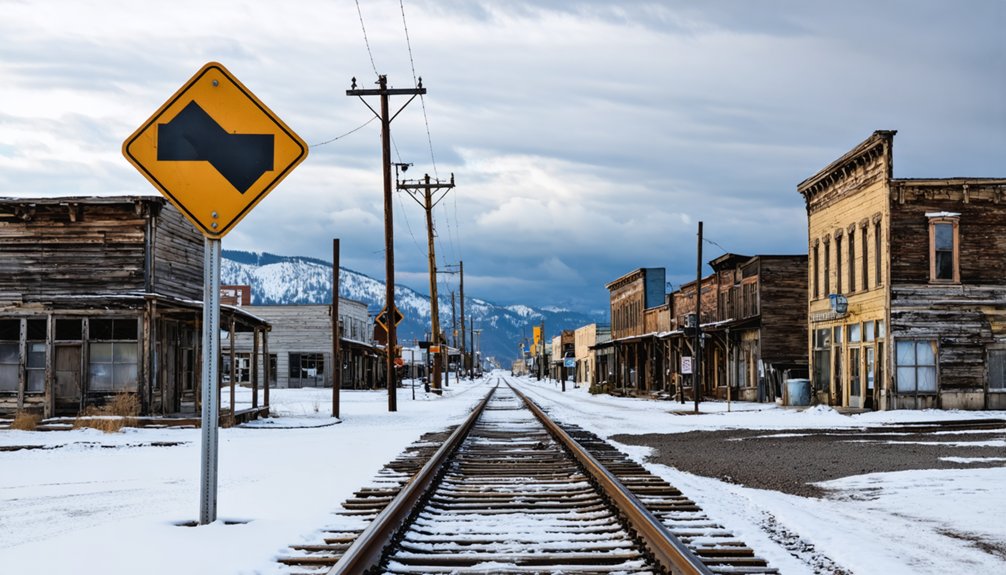
During 1881, rail construction crews began laying track over Soldier Pass, completing roughly 6,000 feet before winter’s harsh conditions halted their progress.
The railway’s evolution transformed this remote mountain pass into a bustling community, as the Denver & Rio Grande Western Railway established essential operations there to help trains navigate the steep 4% grade.
- You’ll find the town reached its peak in the 1920s with 2,500 residents and full services
- The railway’s machine shops and helper engine operations drew workers from Helper to Soldier Summit
- Diesel locomotives later reduced the need for helper engines on the grade
- Track realignment through Tucker and Gilluly spelled the town’s doom
The transportation evolution that built Soldier Summit ultimately led to its decline, as technological advances made the town’s strategic location less imperative for rail operations.
Remaining Structures and Modern Landmarks
Today, a handful of weathered structures stand as silent witnesses to Soldier Summit’s once-thriving community.
You’ll find an operational gas station serving as the town’s primary modern landmark, alongside the historic two-room jail that’s open for exploration. The old schoolhouse, which once educated 25 students, remains a reflection of the community’s educational past.
Concrete foundations reveal the town’s original layout, while scattered ramshackle cabins and deserted houses dot the landscape.
On the south side of the highway, you’ll discover the Confederate soldiers’ graves, marked by white rocks and memorial signs. The Izochorite Mine’s remnants and tailings provide glimpses into the area’s industrial heritage.
Only two or three occupied houses remain, marking a stark contrast to the ghost town’s bustling past.
Historical Legacy and Ghost Town Tourism
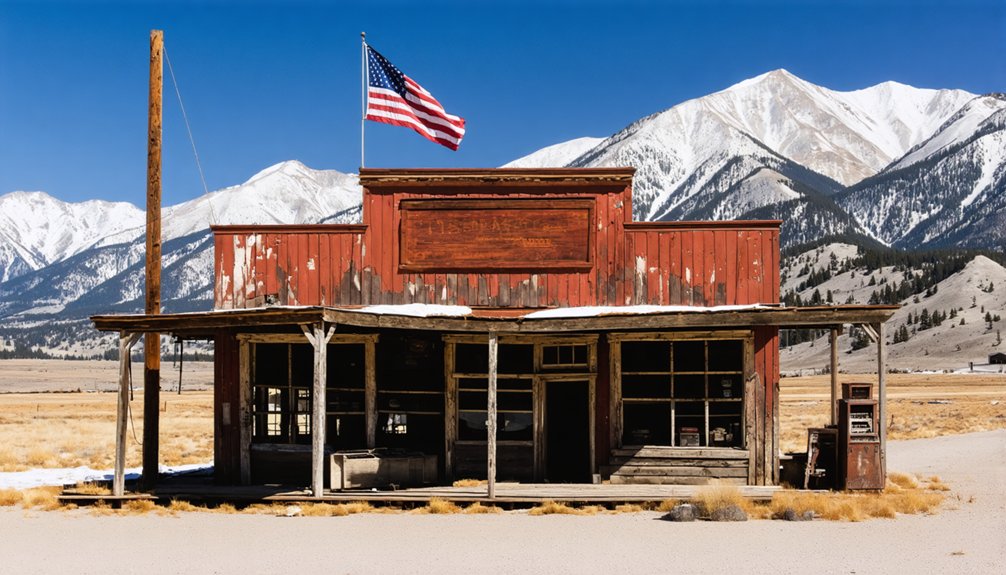
While Soldier Summit‘s bustling days of railroad operations have faded into history, its legacy as a significant transportation hub and military memorial site continues to attract history enthusiasts and ghost town explorers.
You’ll find poignant reminders of the town’s past, including the grass-covered mounds marking the final resting place of soldiers who perished in the 1861 blizzard.
- The original wooden fence surrounding the soldier memorials stands as a tribute to the sacrifices made during early settlement.
- Ghost town exploration reveals concrete foundations and a preserved two-room jailhouse.
- You can trace the town’s evolution from a thriving population of 2,500 to its current ghost town status.
- The site offers a unique glimpse into the challenging railroad and mining era that shaped Utah’s development.
Frequently Asked Questions
Are There Any Paranormal Activities Reported at Soldier Summit?
While you’ll hear local stories of ghost sightings near soldiers’ graves and haunted locations in abandoned buildings, there’s no official documentation of paranormal activity – just anecdotal accounts influenced by the area’s tragic past.
Can Visitors Access the Original Confederate Soldiers’ Burial Sites Today?
Persistent pioneers can find these burial sites today. You’ll need local guidance to access the area, as there aren’t formal visitor regulations. The weathered graves remain visible near the old railroad tracks.
What Was the Town’s Primary Water Source During Winter Months?
You’ll find the town relied heavily on natural springs during winter, though they’d often freeze. They likely maintained storage from these springs and supplemented with controlled snowmelt runoff when accessible.
Did Any Famous Historical Figures Ever Pass Through Soldier Summit?
While countless travelers crossed the summit, records show only one historically significant group – Confederate soldiers who tragically perished there in 1861, leading to the pass’s renaming from Grassy Pass.
Were There Any Major Crimes or Notable Lawbreakers in the Town?
You won’t find records of major crimes in available historical documents. The town’s crime history was limited to minor offenses, with basic law enforcement consisting of a marshal and two-room jail.
References
- https://digging-history.com/2014/08/20/ghost-town-wednesday-soldier-summit-utah/
- https://www.soldiersummitestates.com/area-history
- https://www.impressionevergreen.com/2017/04/soldier-summit-ghostly-site.html
- https://en.wikipedia.org/wiki/Soldier_Summit
- https://www.youtube.com/shorts/EDTFPW0eGz4
- https://utahrails.net/drgw/rg-soldier-summit.php
- http://freepages.rootsweb.com/~gtusa/history/ontheroad/us6f.htm
- http://travellogs.us/2007Logs/Utah 2007/52-Provo-Alpine loop/52aa Price to Provo.htm
- https://www.gwrr.com/utah/history/
- http://www.waltersrail.com/2020/05/rio-grande-across-soldier-summit-and.html
